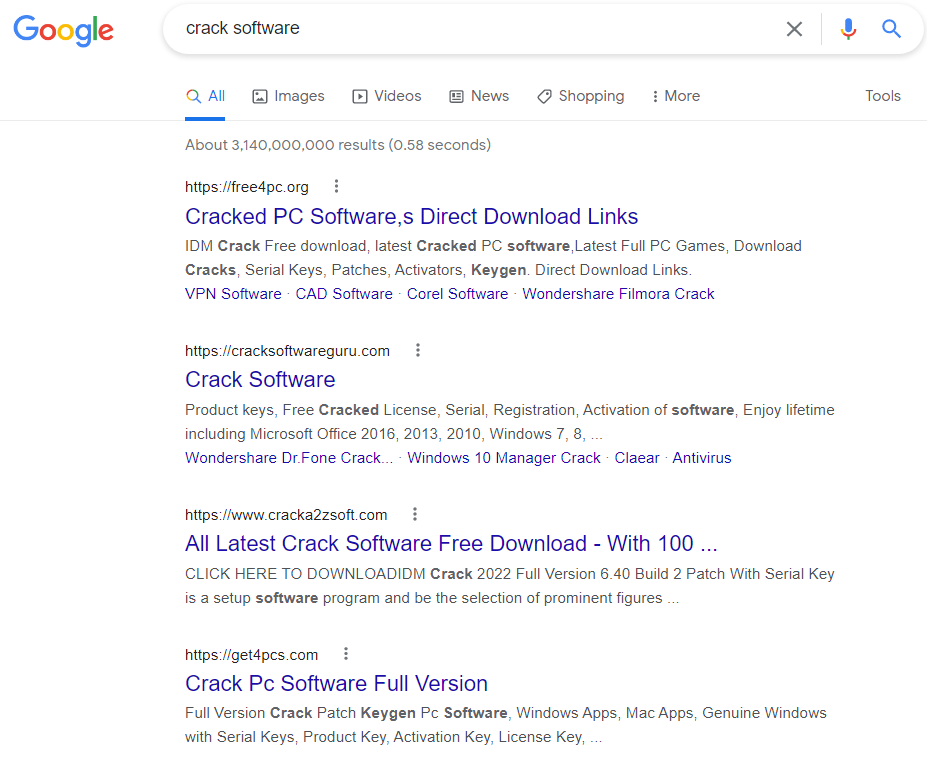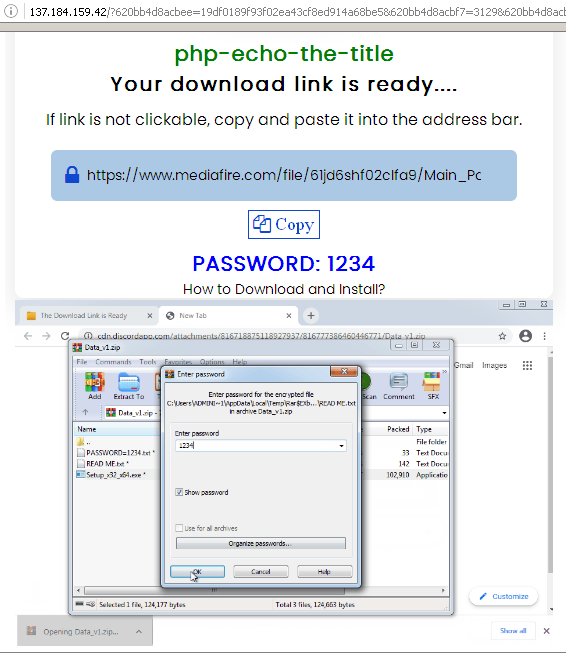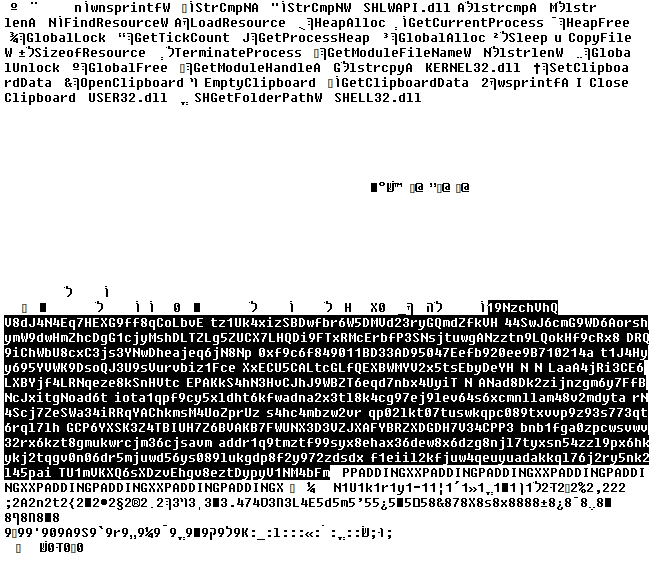
Executive Summary
NullMixer is a dropper leading to an infection chain of a wide variety of malware families. NullMixer spreads via malicious websites that can be found mainly via search engines. These websites are often related to crack, keygen and activators for downloading software illegally, and while they may pretend to be legitimate software, they actually contain a malware dropper.
It looks like these websites are using SEO to stay at the top of search engine results, making them easy to find when searching the internet for “cracks” and “keygens”. When users attempt to download software from one of these sites, they are redirected multiple times, and end up on a page containing the download instructions and archived password-protected malware masquerading as the desired piece of software. When a user extracts and executes NullMixer, it drops a number of malware files to the compromised machine. These malware families may include backdoors, bankers, credential stealers and so on. For example, the following families are among those dropped by NullMixer: SmokeLoader/Smoke, LgoogLoader, Disbuk, RedLine, Fabookie, ColdStealer.
Technical Details
Initial infection
The infection vector of NullMixer is based on a ‘User Execution’ (MITRE Technique: T1204) malicious link that requires the end user to click on and download a password-protected ZIP/RAR archive with a malicious file that is extracted and executed manually.
The whole infection chain of NullMixer is as follows:
- The user visits a website to download cracked software, keygens or activators. The campaign appears to target anyone looking to download cracked software, and uses SEO techniques to make these malicious sites more prominent at the top of search engine results.
Top Google search engine results for “crack software” contain malicious websites delivering NullMixer
- The user clicks on the download link for the desired software.
- The link redirects the user to another malicious website.
- The malicious website redirects the user to a third-party IP address webpage.
- The webpage instructs the user to download a password-protected ZIP file from a file sharing website.
Malware execution instructions
- The user extracts the archived file with the password.
- The user runs the installer and executes the malware.
Example of NullMixer infection chain execution
NullMixer description
NullMixer is a dropper that includes more than just specific malware families; it drops a wide variety of malicious binaries to infect the machine with, such as backdoors, bankers, downloaders, spyware and many others.
NullMixer execution chain
The real infection occurs when the user extracts the ‘win-setup-i864.exe’ file from the downloaded password-protected archive and runs it. The ‘win-setup-i864.exe’ file is an NSIS (Nullsoft Scriptable Install System) installation program, which is a very popular installation instrument used by many software developers. In our case, it dropped and launched another file, ‘setup_installer.exe’, that is in fact an SFX archive ‘7z Setup SFX’ wrapped into a Windows executable. The ‘setup_installer.exe’ file dropped dozens of malicious files. But instead of launching them, it launches a single executable – setup_install.exe – which is a NullMixer starter component. NullMixer’s starter launches all the dropped executable files. To do so, it contains a list of hardcoded file names, and launches them one by one using ‘cmd.exe’.
List of files hardcoded into NullMixer starter component
NullMixer execution chain
It also tries to change Windows Defender settings using the following command line.
|
1 2 |
"cmd.exe /c powershell -inputformat none -outputformat none -NonInteractive -Command Set- MpPreference -DisableRealtimeMonitoring $true -SubmitSamplesConsent NeverSend -MAPSReporting Disable" |
Immediately after all the dropped files have been launched, the NullMixer starter beacons to the C&C about a successful installation. From this point, all the dropped and launched malicious files are left to their own devices. With a little monitoring we can identify a wide variety of malicious binaries that are spread by the NullMixer malware.
NullMixer and malware families it drops
Since the number of families turned out to be quite large, we decided to give only a brief description of each in this report. A full technical description will be provided in subsequent reports.
SmokeLoader
SmokeLoader (aka Smoke) is a modular malware that has been known since 2011, distributed via phishing emails and drive-by downloads. It has evolved its capabilities with additional modules over the years. For example, disabling of Windows Defender and anti-analysis techniques have been added to the malware. However, most threat actors only use the main functionality – payload downloading and executing.
In contrast to the simplest downloaders that download malicious files using hardcoded static URLs, SmokeLoader communicates with the C&C in order to receive and perform download tasks.
RedLine Stealer
RedLine Stealer has been known since early 2020 and developed through 2021. The malware is known to be sold on online forums, and distributed via phishing emails.
A newer method of spreading RedLine Stealer is by luring Windows 10 users to get fake Windows 11 upgrades. When the user downloads and executes the binary, they’re actually running the malware.
RedLine’s main purpose is to steal credentials and information from browsers, in addition to stealing credit card details and cryptocurrency wallets from the compromised machine. Moreover, the malware also collects information about the system, such as: username, hardware details and installed security applications.
PseudoManuscrypt
PseudoManuscrypt has been known since June 2021, and used as MaaS (Malware as a Service). PseudoManuscrypt doesn’t target particular companies or industries, but it has been observed that industrial and government organizations, including enterprises in the military-industrial complex and research laboratories, are the most significant victims.
The malware is known to be distributed via other botnets such as Glupteba. The main aim of the PseudoManuscrypt threat actors is to spy on their victims by stealing cookies from Firefox, Google Chrome, Microsoft Edge, Opera, and Yandex Browser, keylogging and stealing cryptocurrency by utilizing the ClipBanker plugin. A distinctive feature of the malware is the use of the KCP protocol to download additional plugins.
ColdStealer
ColdStealer is a relatively new malicious program that was discovered in 2022. Like many other stealers its main purpose is to steal credentials and information from web browsers, in addition to stealing cryptocurrency wallets, FTP credentials, various files and information about the system such as OS version, system language, processor type and clipboard data. The only known method of delivering stolen information to cybercriminals is by sending a ZIP archive to an embedded control center.
ColdStealer Main() function
FormatLoader
FormatLoader is a downloader that got its name for using hardcoded URLs as format strings, where it needs to fill a single digit to get a link to download an additional binary. The available digit range is also hardcoded.
|
1 2 3 4 |
https://signaturebusinesspark[.]com/360/fw%d.exe => https://signaturebusinesspark[.]com/360/fw3.exe https://signaturebusinesspark[.]com/360/fw%d.exe => https://signaturebusinesspark[.]com/360/fw4.exe … https://signaturebusinesspark[.]com/360/fw%d.exe => https://signaturebusinesspark[.]com/360/fw6.exe |
FormatLoader’s main purpose is to infect the machine with an additional malicious file by downloading the binary to the compromised machine. To do so, the malware adds digits from the hardcoded range one by one to the hardcoded format strings, and accesses the download links.
In addition, FormatLoader uses a third-party website service for tracking the compromised machine. It sends a ‘GET’ request to a specific URL of an IP logger service, which collects information such as IP address and IP-based geolocation.
CsdiMonetize
CsdiMonetize is known to be an advertising platform that used to install many different PUAs (Potentially Unwanted Applications) on a Pay-Per-Install basis after infecting the user’s machine. Later on, rather than just infecting their victim with PUAs, CsdiMoneitze began infecting their victims with actual Trojans, like the Glupteba malware.
Nowadays, CsdiMonetize infects its victims with additional malware family types such as: Fabookie, Disbuk, PseudoManuscrypt and more.
Csdi execution chain
The infection begins with NSIS installer ’61f665303c295_Sun1059d492746c.exe’, which downloads the Csdi installer ‘MSEkni.exe‘. The Csdi installer requests the current configuration from the C&C and a list of additional Csdi components to install. Configuration is stored in several registry keys in encrypted and base64 encoded form. The next step is to download additional components, the most notable being publisher and updater components. The Csdi publisher component is responsible for showing advertisements by launching the browser with URLs as command line parameters. The updater component is responsible for a Pay-Per-Install service. It receives the list of URLs from the C&C and instructions on how to drop and execute downloaded files.
Disbuk
Disbuk (aka Socelar) is known to disguise itself as a legitimate application, such as PDF editor software.
This malware was found to mainly target Facebook Ads and evolved to steal Facebook session cookies from Chrome and Firefox by accessing the browser’s SQLite database. After retrieving this information, the malware attempts to extract additional information like access tokens, account IDs, etc. After further evolution, Disbuk has also started retrieving Amazon cookies.
Besides stealing data, Disbuk also installs a malicious browser extension that masquerades as a Google Translate extension. To get more information about a user’s Facebook account, Disbuk queries Facebook Graph API.
Fabookie
Fabookie is another stealer that targets Facebook Ads. Its functionality is similar to the Disbuk malware, and includes stealing Facebook session cookies from browsers, using Facebook Graph API Queries to receive additional information about a user’s account, linked payment method, balance, friends, etc. Stolen credentials can later be used to run ads from the compromised account.
Unlike Disbuk, this malware does not contain built-in malicious browser extensions, but contains two embedded NirSoft utilities – ‘Chrome Cookies View’ and ‘Web Browser Password Viewer’ – that are used to extract data from browsers.
DanaBot
DanaBot is a Trojan-Banker written in Delphi that spreads via email phishing, and is known to have evolved since it was discovered in 2018.
DanaBot is a modular malware that includes various additional modules; the most popular functionalities of these modules are stealing information from compromised machines and injecting fake forms into popular ecommerce and social media sites to collect payment data. It can also provide full access to infected systems with remote desktop, or mouse and keyboard access by utilizing a VNC plugin.
Racealer
Racealer (aka RaccoonStealer) is known to be a stealer-type malware that mostly extracts user credentials and exfiltrates data from compromised machines.
Racoon is also known to have evolved over the years since it was discovered in 2019. For example, it now uses Telegram to retrieve C&C IP addresses and malware configurations. Moreover, additional modules are now being downloaded from the malware’s C&Cs that are also used to extract credentials.
Generic.ClipBanker
Generic.ClipBanker is a clipboard hijacker malware that monitors the clipboard of the compromised machine, and specifically searches for cryptocurrency addresses in order to replace them. When a user copies an address of a cryptocurrency wallet the malware replaces the address of the wallet with their own cryptocurrency wallet address, so the end user sends cryptocurrencies (such as Bitcoin) to them rather than to the intended wallet address.
Screen with cryptocurrency addresses from Generic.ClipBanker binary
SgnitLoader
The SgnitLoader is a small Trojan-Downloader written in C#. The downloader binary size is about 15 Kbytes. However, the original file is packed with Obsidium, which makes the binary size grow to more than 400 Kbytes.
The SgnitLoader contains a few hardcoded domains in its binary, to which it appends the path and adds a number from 1 to 7. Unlike the FormatLoader malware, it doesn’t use a format string, but simply adds a number to the end of the string in order to get the full URL.
|
1 2 3 4 |
"https://presstheme[.]me/" + "?user=" + "l10_" + "1" => "https://presstheme.me/?user=l10_1" "https://presstheme[.]me/" + "?user=" + "l10_" + "2" => "https://presstheme.me/?user=l10_2" … "https://presstheme[.]me/" + "?user=" + "l10_" + "7" => "https://presstheme.me/?user=l10_7" |
After the download and execute procedures are completed, SgnitLoader pings back to the C&C with a ‘GET’ request. The original pingback URL is hidden with the ‘iplogger.org’ URL shortener service.
ShortLoader
Another small Trojan-Downloader written in C#. Its binary is half the size of SgnitLoader. Its main function code is fairly short and it uses the ‘IP Logger‘ URL shortener service to hide the original URL that it downloads the payload from. That’s why it’s called ShortLoader.
ShortLoader Main() function
Downloader.INNO
The original file is an ‘Inno Setup’ installer that utilizes ‘Inno Download Plugin’ download functionality.
The setup script is programmed to download a file from the URL ‘http://onlinehueplet[.]com/77_1.exe‘ placing it into the ‘%TEMP%‘ directory as ‘dllhostwin.exe‘ and executing it with the string ’77’ as an argument.
Part of Inno Setup installation script
The downloaded file belongs to the Satacom Trojan-Downloader family. However, in the course of our research we discovered that this file was replaced on the server with legitimate PuTTY software, a popular SSH client.
LgoogLoader
This file is another software installer that uses the Microsoft Cabinet archive-file format. After execution, it drops three files: a batch file, an AutoIt interpreter with a stripped executable header and an AutoIt script. Then it executes the batch file with ‘cmd.exe’. The task of the batch file is to restore the AutoIt interpreter executable, and launch it with a path to the AutoIt script as a command line argument.
AutoIt script performs a few AntiVM and AntiDebug checks. If all the checks are successful, then it starts AutoIt interpreter once again, decrypts and decompresses the embedded executable and injects it into the newly created process. The injected executable is LgoogLoader.
LgoogLoader is a Trojan-Downloader that downloads an encrypted configuration file from a hardcoded static URL. It then decrypts the configuration, extracts additional URLs from it and downloads and executes the final payloads. It was called LgoogLoader due to its use of strings from ‘Google Privacy Policy’.
Google Privacy Policy strings in LgoogLoader’s binary
Downloader.Bitser
The original file is an NSIS installer that tries to install PUA: Lightening Media Player. The file is downloaded by CsdiMonetize’s updater component (MD5: 98f0556a846f223352da516af66fa1a0). However, the installation script is configured not only to set up Lightening Media Player, but also to run the built-in Windows utility ‘bitsadmin’ to download additional files, which is why we call it Bitser. In our case, the utility was used inside the installation script of the NSIS installer, and used to download a 7z password-protected archive. The password for the 7z archive and instructions for unpacking and execution are also hardcoded into the installation script.
Downloader.Bitser’s infection chain
A legitimate 7-Zip Standalone Console application is dropped by the installer under the name ‘data_load.exe‘ and launched with arguments to unpack files from the downloaded archive.
Part of NSIS script with download and execute instructions
C-Joker
C-Joker is an incredibly simple Exodus wallet stealer. It uses the Telegram API to send notifications about successful or failed installations. In order to steal credentials, it downloads a backdoored version of the ‘app.asar’ file and replaces the original file from the Exodus wallet.
String in C-Joker’s binary
PrivateLoader
PrivateLoader is yet another example of a Pay-Per-Install malicious loader like LgoogLoader and SmokeLoader. It uses a single-byte XOR encryption key to receive URLs from the control center.
Satacom
Satacom is also known as LegionLoader. Discovered in 2019, Satacom uses different anti-analysis tricks that were probably borrowed from the al-khazer stress tool. The embedded user agent varies from sample to sample, but in our case the user agent is “deus vult”.
Strings in Satacom binary
The latest version receives the main control center address from TXT-record. Satacom sends a DNS TXT-query to ‘reosio.com‘ and receives a response with a base64 encoded string.
Satacom DNS request and response
After decoding and decrypting with the XOR key “DARKMATTER” it gets the real C&C URL ‘banhamm.com‘.
Satacom C&C communication
GCleaner
GCleaner is another Pay-Per-Install malicious loader. It was discovered at the beginning of 2019. Initially it was distributed as a cleaning tool called Garbage Cleaner or G-Cleaner through a fake website mimicking popular cleaning tools like CCleaner. The main loader was used to download potentially unwanted applications together with malware such as Azorult, Vidar, PredatorTheThief, miners and so on. GCleaner is now distributed by various crack websites along with other malware. This PPI platform uses C&C-based geolocation targeting, meaning it can push different malware depending on the victim’s IP address. Although the GCleaner loader is no longer mimicking cleaning tools, there are some still remnants of this in its binary code such as encrypted strings like “Software\GCleaner\Started” or “\Garbage.Cleaner”. The sample of GCleaner that we detected when analyzing this campaign was trying to download the Vidar password stealer.
Vidar
Vidar is an info-stealer. It downloads DLL files freebl3.dll, mozglue.dll, msvcp140.dll, nss3.dll, softokn3.dll and vcruntime140.dll from its C&C for use in password-grabbing routines. Vidar can also receive settings from the C&C that tells it exactly what to do. It is able to steal autofill information from web browsers, cookies, saved credit cards, browser history, coin wallets and Telegram databases. It also can make and send screenshots to the C&C, as well as any file that matches a specified mask.
Vidar downloads DLL files and uploads collected data
Victims
Since the beginning of the year we’ve blocked attempts to infect more than 47,778 victims worldwide. Some of the most targeted countries are Brazil, India, Russia, Italy, Germany, France, Egypt, Turkey and the United States.
Attribution
We are currently unable to directly attribute NullMixer to any group.
Conclusions
Trying to save money by using unlicensed software can be costly. A single file downloaded from an unreliable source can lead to a large-scale infection of a computer system. As we can see, a large proportion of the malware families dropped by NullMixer are classified as Trojan-Downloaders, which suggests infections will not be limited to the malware families described in this report. Many of the other malware families mentioned here are stealers, and compromised credentials can be used for further attacks inside a local network.
Appendix I – Indicators of Compromise
Malicious ULRs
hxxps://azilominehostz.xyz/
hxxps://patchlinks.com/
hxxp://137.184.159.42/
hxxp://185.186.142.166/wallet.exe
hxxps://dll1.stdcdn.com/
hxxp://tg8.cllgxx.com/hp8/g1/yrpp1047.exe
hxxp://eurekabike.com/pmzero/design/img/LightCleaner9252839.exe
hxxps://i.xyzgamei.com/gamexyz/2201/random.exe
hxxp://www.sxhxrj.com/askhelp35/askinstall35.exe
hxxps://presstheme.me/
hxxp://remviagra.com/pub1.exe
hxxp://privacy-tools-for-you-782.com/downloads/toolspab2.exe
hxxps://cdn.discordapp.com/attachments/917889480646590537/935966171835031612/Cube_WW6.exe
hxxp://onlinehueplet.com/77_1.exe
hxxps://cdn.discordapp.com/attachments/934006169125679147/943432754161410108/WW19.exe
hxxp://privacy-tools-for-you-791.com/downloads/toolspab1.exe
hxxps://cdn.discordapp.com/attachments/917889480646590537/943130993404018709/Fixtools.exe
hxxp://stylesheet.faseaegasdfase.com/hp8/g1/rtst1051.exe
hxxp://104.168.215.231/kde.exe
hxxp://careerguide4u.online/wp-content/plugins/google-analytics-for-wordpress/BlackCleanerSetp521234.exe
hxxps://i.xyzgamei.com/gamexyz/2203/random.exe
hххp://zenitsu.s3.pl-waw.scw.cloud/pub-summoning/poweroff.exe
hххps://tengenuzui.s3.pl-waw.scw.cloud/makio/cpm_pr_vp46up4d6j_.exe
hххps://tengenuzui.s3.pl-waw.scw.cloud/makio/updto_bgn64wau5x_date.exe
hххps://tengenuzui.s3.pl-waw.scw.cloud/makio/handler_wbba4vzm89rxskhs.exe
hxxps://i.xyzgamei.com/gamexyz/25/random.exe
hххps://v.xyzgamev.com/25.html
hххps://v.xyzgamev.com/login.html
hxxp://jackytpload.su/campaign6/autosubplayer.exe
hxxps://gc-distribution.biz/pub.php?pub=five
hxxp://www.sxhxrj.com/askhelp42/askinstall42.exe
hxxps://flexnetinformatica.com.br/wp-content/plugins/elementor/assets/LightCleaner2132113.exe
hxxp://stylesheet.faseaegasdfase.com\/hp8/g1/siww1053.exe
hxxps://source3.boys4dayz.com/installer.exe
hxxps://signaturebusinesspark.com/360/fw3.exe
hxxps://signaturebusinesspark.com/360/fw4.exe
hxxps://signaturebusinesspark.com/360/fw6.exe
hxxps://cdn.discordapp.com/attachments/937783814208491553/937784072967692368/SecondFile.exe
hххps://v.xyzgamev.com/23.html
hххps://v.xyzgamev.com/login.html
Malware C&Cs
178.62.113[.]205/runtermo
185.163.204[.]22/runtermo
185.163.45[.]70/runtermo
185.186.142[.]166
185.215.113[.]10
185.38.142[.]132
212.193.30[.]21/base/api/
212.193.30[.]45/proxies.txt
5.9.224[.]217
92.255.57[.]115
ads-memory[.]biz
all-mobile-pa1ments.com[.]mx
all-smart-green[.]com
am1420wbec[.]com/upload/
appwebstat[.]biz
banhamm[.]com
buy-fantasy-fo0tball.com[.]sg
buy-fantasy-gmes.com[.]sg
connectini[.]net
dll1.stdcdn[.]com
dollybuster[.]at/upload/
egsagl[.]com/upload/
enter-me[.]xyz
fennsports[.]com/upload/
file-coin-host-12[.]com
ginta[.]link
hhiuew33[.]com/check/safe
host-data-coin-11[.]com
islamic-city[.]com/upload/
mordo[.]ru/upload/
nahbleiben[.]at/upload/
noblecreativeaz[.]com/upload/
one-wedding-film[.]com
piratia-life[.]ru/upload/
presstheme[.]me
real-enter-solutions[.]xyz
recmaster[.]ru/upload/
remik-franchise[.]ru/upload/
reoseio[.]com
signaturebusinesspark[.]com
sovels[.]ru/upload/
spaldingcompanies[.]com/upload/
toa.mygametoa[.]com
topexpertshop[.]com
topniemannpicksh0p[.]cc
tvqaq[.]cn/upload/
whsddzs[.]com/Home/Index/djksye
ColdStealer hashes
06B31367D65A411B1F2A7B3091FB31D4
584B186152A16161E502816BF990747C
C41A85123AF144790520F502FE190110
CsdiMonetize hashes
5B14369C347439BECACAA0883C07F17B
7E58613DDB2FDD10EED17BBCE5B3E0A9
883403C940B477CEE083EFEEA8C252C6
98F0556A846F223352DA516AF66FA1A0
CEADA3798FD16FAC13F053D0C6F4D198
DanaBot hashes
D91325640F392D33409B8F1B2315B97C
Disbuk hashes
3739256794EBF9BA8C6597A4687C8799
FBD3940D1AD28166D8539EAE23D44D5B
Downloader.Bitser hashes
AAEFF1F8E7BD3A81C69C472BCD211A7B
Downloader.INNO hashes
E65BF2D56FCAA18C1A8D0D481072DC62
Fabookie hashes
33F7383C2EB9B20E11E6A149AA62DEA4
79400B1FD740D9CB7EC7C2C2E9A7D618
FormatLoader hashes
B8ECEC542A07067A193637269973C2E8
GCleaner hashes
42100BAF34C4B1B0E89F1C2EF94CF8F8
Generic.ClipBanker hashes
4D75DEA49F6BD60F725FAE9C28CD0960
LgoogLoader hashes
CC722FD0BD387CF472350DC2DD7DDD1E
4008D7F17A08EFD3FBD18E4E1BA29E00
B2A2F85B4201446B23A250F68051B4DC
NullMixer hashes
4EC312D77817D8FB90403FF87B88D5E3
12DBC75B071077042C097AFD59B2137F
F94BF1734F34665A65A835CC04A4AD95
PrivateLoader hashes
362592241E15293C68D0F24468723BBB
7875AAB3E23F885DF12FF62D9EF5DB50
PseudoManuscrypt hashes
B0448525C5A00135BB5B658CC6745574
D5C1C44D19D8D6E8C0F739CAB439E45E
Racealer hashes
4FEBA8683DAA18545E9F9408E4CD07BD
RedLine hashes
446119332738133D3ECD2D00EBE5D0EC
5994DE41D8B4ED3BBB4F870A33CB839A
9F8800BF866E944EFB2034EC56ED574E
AC458CABFED224353545707DF966A2BA
AF817AAD791628143019FFDE530D0EF7
Satacom hashes
2086E25FB651F0A8D713024DE2168B9B
SgnitLoader hashes
B2620FFE40493FDF9E771BFF3BDCBC44
4DD3F638D4C370ABEB3EBF59CAD8ED2F
ShortLoader hashes
CE54B9287C3E4B5733035D0BE085D989
SmokeLoader hashes
9F1EAA0FF990913F7D4DFD31841DE47A
Vidar hashes
639DE55E338BFCEA8DAAE727141AF3D1
NullMixer: oodles of Trojans in a single dropper










































C. Wayne Lewis
Great information!!!